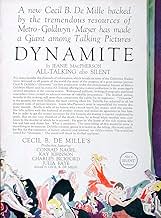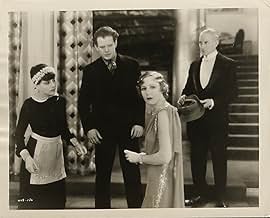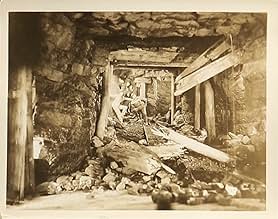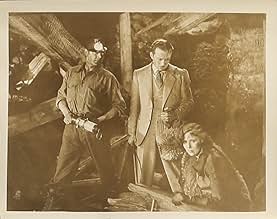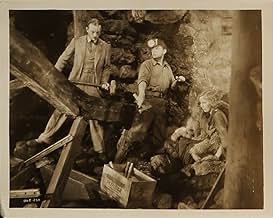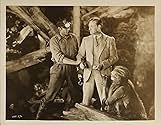Agrega una trama en tu idiomaWealthy Cynthia is in love with not-so-wealthy Roger, who is married to Marcia. The threesome is terribly modern about the situation, and Marcia will gladly divorce Roger if Cynthia agrees t... Leer todoWealthy Cynthia is in love with not-so-wealthy Roger, who is married to Marcia. The threesome is terribly modern about the situation, and Marcia will gladly divorce Roger if Cynthia agrees to a financial settlement. But Cynthia's wealth is in jeopardy because her trust fund will ... Leer todoWealthy Cynthia is in love with not-so-wealthy Roger, who is married to Marcia. The threesome is terribly modern about the situation, and Marcia will gladly divorce Roger if Cynthia agrees to a financial settlement. But Cynthia's wealth is in jeopardy because her trust fund will expire if she is not married by a certain date. To satisfy that condition, Cynthia arrange... Leer todo
- Dirección
- Guionistas
- Elenco
- Nominado a 1 premio Óscar
- 1 premio ganado y 1 nominación en total
- Bobby
- (as Douglas Frazer Scott)
- Good Mixer
- (sin créditos)
- Mine Foreman
- (sin créditos)
Opiniones destacadas
Of interest especially is the fact that you can recognize the stage training of many of the actors brought to Hollywood with the advent of sound, and how wooden previously silent actors can be when given voice. Also interesting is the characters' flagrant flouting of Prohibition, which still had 4 years left - after all, this was "pre-Code" Hollywood when there wasn't a censor to be found!
Most significant is the sound. The scene which annoys modern viewers is the chaos in the jailhouse wedding scene. However, this is one of the first instances of layered sound: the hammering of the gallows over the prisoner's singing over the wedding vows was a first for a medium that had gone talkie only a year & a half earlier.
So watch it for the details, not the drama
I got lucky because they broadcast this on TCM the same week the classic movie channel premiered their recent biography 'Cecil B. DeMille: American Epic (2004)', another TCM film worth watching. It is devoid of the usual colossal cast and the behemoth type epic drama associated with most DeMille movies but am I ever glad I stayed up late for this one...the sets and costuming were pure eye candy! And while it is more simplistic than movies we think of as DeMille classics there are some remarkable scenes in this film including a glass walled bathtub with bath salts as big as the coal chunks mined out of the heroines'temporary' husband's work place. I'll not quickly forget the women's 'aero wheels' event during the sporting day at the country club. Could this have even been the inspiration to the wacky Busby Berkeley extravaganzas that didn't appear for at least another four years after 'Dynamite'? The costumes in this movie are museum worthy. There's also tremendous amount of Deco decor which is discriminating and sublime as a period piece.
The plot premise is rather sappy...spoiled rich kid falls for poor coal miner who teaches her a lesson in reality...where haven't we all heard that story before... but it's easy to forgive some minor flaws with this picture because visually it's too damn delicious to forget. The acting was decent and at times even humorous, especially amongst the love triangle. This relationship was obliging liberated given the era. And oh...the parties!
I also appreciate the lushness of a truly dynamic black and white movie from someone who understood how color translates when it desaturates. If I saw this movie when it premiered I would have marked it an 8 1/2 on a scale of 10.
DeMille's first sound talking movie under Metro-Goldwyn-Mayer was December 1929's "Dynamite." The director looked towards perfection in his selection of articulate talented actors. Mitchell Leisen, DeMille's assistant as well as his set designer for this movie, screen tested dozens of potential candidates. The list was a who's who in future stars: Dean Jagger, Randolph Scott, Carole Lombard. Two of the three top roles were filled by stage actors appearing in their first movie. The other was a veteran of silent movies.
Actress Kay Johnson earned the lead as socialite Cynthia Crothers, a woman who is passionately in love with married Roger Towne (Conrad Nagel). Cynthia is about to inherit a large inheritance from her late rich grandfather, but has to marry within a month to get it. Since Roger's pending divorce won't come in time, accused murderer Hagon Derk (Charles Bickford), on death row, wants to donate his body to whomever is willing to pay him $10,000 to help his poor sister. Cynthia, seeing his ad, goes to propose a marriage for the money. He accepts. They get married. Minutes before his execution, the real murderer confesses, freeing Derk. That's when things get really interesting for the coal miner Derk, Cynthia and Roger.
DeMille was ready to make movies with the microphone. As his publicist stated, "Cecil DeMille will rehearse the cast of Dynamite until it is letter perfect. This is the first time he has directed dialogue rehearsals since he left Broadway sixteen years ago." The director himself publicly stated he wasn't intimated by the new process: "Dynamite" was my first contribution of any value to sound pictures, retaining the silent techniques, and combining those techniques with sound. I brought those two together, and that perhaps is what 'Dynamite' did for the world." The movie was helped by the strong performances of the three main actors. Kay Johnson attended the American Academy of Dramatic Arts in New York City and appeared in several Broadway plays before getting the call-up from DeMille to appear as Cynthia. During the production, she came down with appendicitis and had to be operated on. Her movie career slowed down in the late 1930s after a robust series of film roles until she and her actor/director husband, John Cromwell, adopted a child and had one of their own, James. Fans of the TV show 'All in the Family' will recognize her son James as Archie's friend Stretch Cunningham. When Johnson divorced John in 1946, she remained in Waterford, CT., where she died at 71.
Charles Bickford, as Hagan Derk, was also a stage actor, playing alongside James Cagney in his first Broadway role in 1925's 'Outside Looking In.' His forceful film presence resembles his real personality as a strong outspoken character. At nine he was charged with attempted murder for shooting a trolly driver after his bus ran over his dog. When filming 'Dynamite," Bickford got in a physical fist fight with one of the assistant directors over his portrayal of Derk, and was always at odds with MGM studio head Louis Mayer. As a freelancer in the mid-1930s, he was mauled by a lion filming 1935's "East of Java," resulting in extensive neck scars. He never quite achieved top-tier star status, but became a popular character actor, earning three Academy Award nominations.
Busy actor Conrad Nagel was already in his 11th talkie. He was one of the few silent film stars to easily make the transition to the movie sound stage, working into the late 1950's after his film debut in 1918.
"Dynamite" was the first DeMille picture to earn an Academy Awards nomination. Leisen, the man who screen tested all the main actors in "Dynamite," was nominated for Best Art Direction.
Ordinarily I'm not that huge a fan of DeMille, but I found his first foray into sound, "Dynamite", a very good and innovative film. The actors don't speechify endlessly, the camera moves, and the story moves with it. Unlike many films from 1929 it's worth a repeat viewing for the entertainment value, not just the novelty of seeing an industry in transition.
That doesn't mean that there isn't plenty of an industry in transition on exhibit, but rather than inane musical numbers, De Mille uses sound appropriately and also employs largely unknown actors from the stage to keep the emphasis on the plot and in particular, the relationships. From the hammering of the builders of Hagan Dirk's gallows and the singing of "How Am I to Know" by a fellow death row prisoner played by Russ Columbo during the wedding scene, to the strange aero wheel race at the country club, to the playing of a particular song on the radio introducing a romantic moment, this film was an innovative technological marvel when it was first released. However, technological marvels fade with time, and what you do remember are relationships that hit home and are memorable. Many have already stated the outrageous premise of the plot. What is not outrageous and rings true after almost 85 years is how you don't get to pick who you love - it just happens and it can often be most inconvenient, and how heroes can be found in the strangest places and in people you would not think would be up to the task.
I'd recommend this one highly and not just to early talkie enthusiasts.
¿Sabías que…?
- TriviaCarole Lombard was replaced during filming, but can still be seen in the released print.
- Citas
Hagon Derk: Ahhhh... bull!
- Créditos curiososFilm Title is shown as the word DYNAMITE written on a box of..... dynamite, after being set down by a worker.
- Versiones alternativasMGM also released this as a silent movie.
- ConexionesEdited into Histoire(s) du cinéma: Fatale beauté (1994)
- Bandas sonorasHow Am I to Know
(1929) (uncredited)
Music by Jack King
Lyrics by Dorothy Parker
Played on guitar and sung by Russ Columbo in prison
Played on radio and hummed and sung by Kay Johnson
Played on piano as background music and played at the end
Selecciones populares
Detalles
- Tiempo de ejecución2 horas 9 minutos
- Color
Contribuir a esta página


